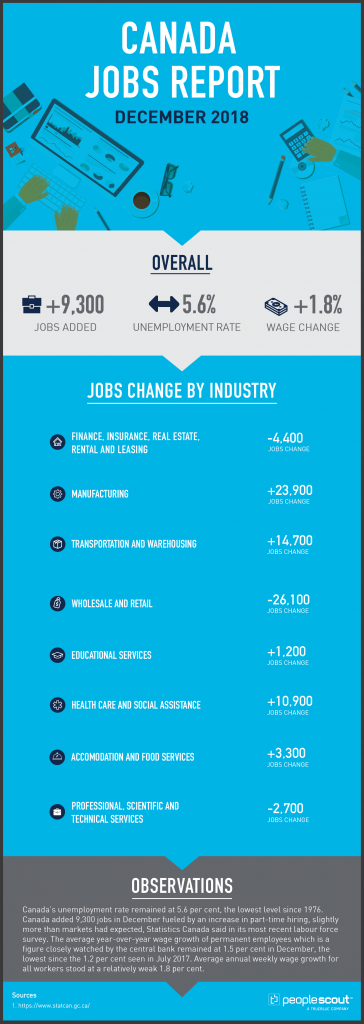Canada’s unemployment held steady in December as job creation neared market expectations following a large increase in hiring November. Statistics Canada reported that the Canadian economy added 9,300 jobs last month. Market expectations were for an increase in employment of 10,000, according to economists at Royal Bank of Canada. In November, Canadian employment rose by 94,100, so the jobs added in December are a steep decline from the previous month. Canada’s unemployment rate was 5.6% in December, unchanged from November when it fell to its lowest level in more than 40 years.

The Numbers
9,300: The economy gained 9,300 jobs in December.
5.6%: The unemployment rate remained at 5.6%.
1.8%: Weekly wages increased to 1.8% over the last year. This is a 0.3% increase from November’s wage growth figure.
The Good
In 2018, employment increased by 163,000 or 0.9%. In 2018, the unemployment rate fell 0.2 percentage points to 5.6%. Full-time employment continued on an upward trend in 2018, growing by 185,000 or 1.2%, while part-time employment barely changed.There were some job gains in important sectors in the Canadian economy in December including transportation and warehousing; healthcare and social assistance as well as manufacturing.
Manufacturing added 23,900 jobs which is an increase of 1.4% in a one month period.
The year had notable gains for Canadian women and older male workers. Among the core-working-age population (aged 25 to 54), employment in 2018 increased notably for women (+126,000 or +2.2%) and for men (+61,000 or +1.0%). At year end, the unemployment rate among this age group was 4.6% for women and 4.8% for men. For men and women aged 55 and over, employment rose by 50,000 (+1.2%) in 2018, with most of the increase among men (+43,000 or +2.0%), whose unemployment rate fell 0.8 percentage points to 5.3% over the period. For women in this age group, employment was little changed but remained strong, with their unemployment rate at 4.6%.
The Bad
The 0.9 per cent jobs growth rate in 2018 shows that the rate of growth has slowed compared with 2017 (+2.3 per cent) and 2016 (+1.2 per cent). Lackluster wage growth continues to be a concern and even a mystery as The Financial Times notes:
“Overall, average hourly wages increased two per cent in December from a year earlier, lifting the five-month trend to about 2.2 per cent. So, after several years of good-to-great aggregate employment growth, wages are only keeping pace with inflation. That’s as odd as it is disappointing.
Before this year, the jobless rate rarely fell below six per cent. Now it’s the ceiling. The unemployment rate was 5.6 per cent in November and December, the lowest in data that dates to 1976, and it has brushed six per cent only twice since November 2017.
With hiring at levels that economists associate with full employment, you’d expect stronger upward pressure on salaries. But for whatever reason, that’s not happening.”
The Unknown
Some experts consider early 2019 to be the late stages of a positive economic cycle for Canada, setting off speculation on when the next recession will start and generating concern in provinces like Alberta which have experienced recent economic difficulties:
“‘We are in the late stages of a business cycle,’ Craig Alexander, chief economist of Deloitte said. ‘That doesn’t mean that a recession is around the corner, but we need to recognize that we’re 10 years into an economic recovery, expansion. Business cycles are typically eight to 10 years long.’
Alexander said markets are probably overreacting to the possibility that another downturn could be almost upon us. He thinks the more likely case is that growth will continue to slow.
The economy’s evolution will have different impacts depending where one lives, he added.
For example, the energy sector faces big challenges.
Part of it comes from the recent plunge in oil prices, but there’s also been an extra discount on the price of western Canadian crude caused by transportation bottlenecks out of the Alberta oilpatch.
‘This is sad news for Alberta,’ Alexander said. ‘They’ve only barely recovered from the last recession.’”



